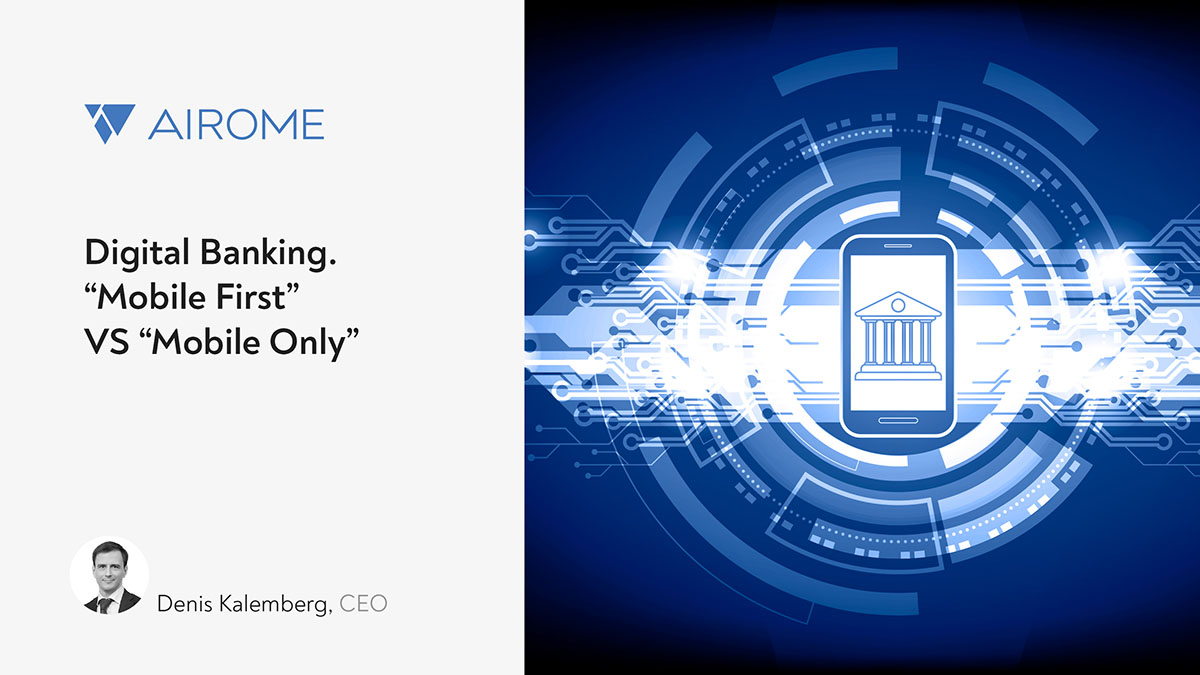Digital Banking. “Mobile First” VS “Mobile Only”
Posted on 24.08.2020 at 10:32

By Denis Kalemberg, CEO
During recent years, the topic of marketplaces/ecosystems/super-apps based on either banks or FinTech companies has been on the radar and has often been mentioned at many financial events. Though, in my view, the ASEAN market has just now started forming its understanding of why these ecosystems are needed and how they are supposed to look like. The latest wave of digital banking development shows that the ASEAN market is ready to adopt a new type of financial services.

In the development of remote digital channels for its customers these days, any bank chooses one of the three most common strategies:
- The “classic” remote services strategy, which implies the simultaneous and harmonious development of online and mobile banking.
- The “mobile first” strategy, which assumes optimization of digital channels foremost for mobile device users, and only then (on a “residual” basis) for laptop and desktop users.
- The “mobile only” strategy (only for mobile-based Internet access), which is a simplified case of the previous strategy, when resources for the Internet banking development cease to be allocated at all.
These strategies generally correspond to the approaches formulated by Internet resources and cloud services developers. Let’s consider each strategy, the arguments that favor them being chosen by banks to serve RBS clients, and trying to understand which of them will prevail in the financial market in the nearest future.
Harmony in Digital Channels
The strategy of simultaneous and uniform development of online and mobile banking is typical for banks with an extensive remote customer service history. Broadly speaking, RBS channels in these banks formed gradually: from “classical” online banking to “innovative” mobile banking, which gained demand when mobile Internet access started its widespread inception. Typically, banks have been accumulating remote banking expertise over the years in the course of a continuous systematic development process. For a time, a mobile application was kind of a limited in capabilities “add-on” to online banking, however, in recent years the situation changed. In view of this, the beginning of the era of mobile banking has become an additional impetus for digital channels to increase the capabilities of mobile users: a new approach to presenting information, a new approach to accessing the functionality of the system itself, to ensuring a high level of its ergonomics and transaction security. At the same time, the development of online banking has not stopped either. The system for “classic” RBS clients, both legal entities and individuals, continued to incorporate the most innovative solutions and technologies that are in demand by mobile users too. In particular, banks started to actively use mobile signatures to confirm transactions and sign digital documents.
“Mobility Above All”
Meanwhile, the trend towards the transition of digital banking services to mobile applications has become so obvious that it is no longer necessary to provide extensive statistics to justify it. According to a number of EU banks, at the end of 2019, the ratio of customers using a mobile application ranged from 58% to 72%, and during Q1, the share of mobile users increased and reached 82%. And this is quite understandable, mobile banking simplifies customer access to managing their accounts, allows customers to constantly monitor their account’s status, make payments at any time, transfer money between accounts, deposits, open new accounts, and issue new credit cards. In turn, the bank receives a sharp increase in the number of contacts with a customer, increased in brand loyalty, and opportunities to sell new services.
Thus, mobile banking has become not a whim, but one of the key conditions for the existence of not only the bank’s retail business, but also for the corporate segment (at least its SMB segment), whose representatives use mobile devices most of all. And it’s not surprising that many banks chose the Mobile First path and focused their main efforts on developing mobile banking. At the same time, the development of “classical” online banking has been slowed down (if not suspended at all)—the priority of projects in this direction were reduced. Banks began to not only to “bring up” the capabilities of mobile users to the high level of online banking, but placed a bet on these users identifying them as their key customers.
“Nothing But Mobility!”
Over time, the so-called “Neobanks” appeared on the market, which went even further towards the development of mobile banking and completely abandoned the web version of their digital channels, leaving only a mobile application to interact with their audience. In a sense, this was a logical decision, given that customers of “officeless” organizations are most often young people who are used to solving all their issues via a smartphone. In an attempt to get these customers, neobanks did not try to catch up with their competitors with “traditional” RBS, but, on the contrary, began to set the rules in a new and actively developing segment of mobile banking, where everyone was in equal conditions, and where “youth” and “assertiveness” could beat “experience”. It was a deliberate and well-thought-out choice that was named “Mobile Only”. This strategy really works for the young segment of the audience, but if you expand the sample, it turns out that not all customers want to be limited in the means of remote working with their account.
“Mobile First” or “Mobile Only”. What to prefer under the current conditions?
So, what has the pandemic period shown? Data from the largest EU banks indicate a trend in Q2 2020 on slowing down the “flow” of customers from online banking to mobile banking, or even some “revival” of customer interest in online banking. All banks have their own statistics, but the same trend has emerged for many banks. What was the reason for this?
On the one hand, availability of devices has had a significant impact. At home, when people have a laptop or desktop with a large monitor at hand, many bank customers preferred to use them. Tentatively speaking, if a bank customer is “in constant motion”, then they most likely will not even turn on a laptop (not to mention a desktop computer), but if they are already within a “home office”, then they are more likely to choose to work with an online bank using a large monitor.
On the other hand, experts argue that this continued interest in online banking is due to the different functionalities of online and mobile banking, as well as the different tasks tackled by customers. Once desktops or laptops became more accessible to users, these differences became immediately visible. Consider: Mobile banking simplifies “atomic” periodically repeating actions that are compactly and conveniently presented to customers on their smartphone screen: payments and purchases, transfers, or viewing balances. At the same time online banking helps customers solve more complex tasks that require more data to be reflected and deeper analysis: studying the bank’s personal offers, choosing loan and investment options, viewing statistics and planning, or performing complex operations that require checking a large number of details (e.g., currency transfers).
What conclusion should be drawn and how can a bank determine its strategy for the further development of its digital channels? First, a developed mobile application is a must! It ensures commitment and loyalty of the most active and promising share of customers—private users and SMB representatives, those who will determine the state of the economy in the near future. Second, and at the same time, it is necessary to have developed online banking channels. Nevertheless, it’s a desktop or laptop that provide users with the highest level of convenience in working with analytical information and the most complete set of opportunities for managing account funds.
Thus, the strategy of “harmonious” development of digital channels for servicing the bank’s customers has now unexpectedly become the most promising one. This also brings to the forefront such issues as the system functionality completeness, clear development plans, usability, high-quality user support, the promptness of deployment and launch of innovative financial and related services, as well as ensuring the safety of user actions.
